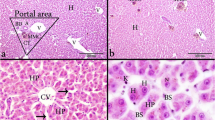Abstract.
An experimental model was designed to study the acute lesions caused by a continuous exposure to 2,4-dichlorophenoxyacetic acid (2,4-D) disolved in water (400 mg/L) in hematopoietic kidney tissue in tench (Tinca tinca L). Fifty fish were used in this study, 15 for calculating LC50 and 35 were euthanized 1, 2, 5, 8, and 12 days postpoisoning (five treated and two controls each time). Tissue samples, fixed in 5% glutaraldehyde in 0.1 M phosphate buffer (pH 7.2) for histopathological examination, revealed marked alteration of hematopoietic tissue, characterized by progressive swelling and cell necrosis, activation of the phagocyte system, and subsequent formation of myelin figures. Variations recorded in hematocrit and hemoglobin levels in blood samples indicated changes in membrane permeability, complementing the findings on hematopoietic tissue. The lethal dose (LC50) at 96 h demonstrated the importance of the species and chemical form used as factors in calculating a product's toxicity.
Similar content being viewed by others
Author information
Authors and Affiliations
Additional information
Received: 16 June 1997/Accepted: 2 April 1998
Rights and permissions
About this article
Cite this article
Gómez, L., Masot, J., Martínez, S. et al. Acute 2,4-D Poisoning in Tench (Tinca tinca L.): Lesions in the Hematopoietic Portion of the Kidney. Arch. Environ. Contam. Toxicol. 35, 479–483 (1998). https://doi.org/10.1007/s002449900405
Published:
Issue Date:
DOI: https://doi.org/10.1007/s002449900405




